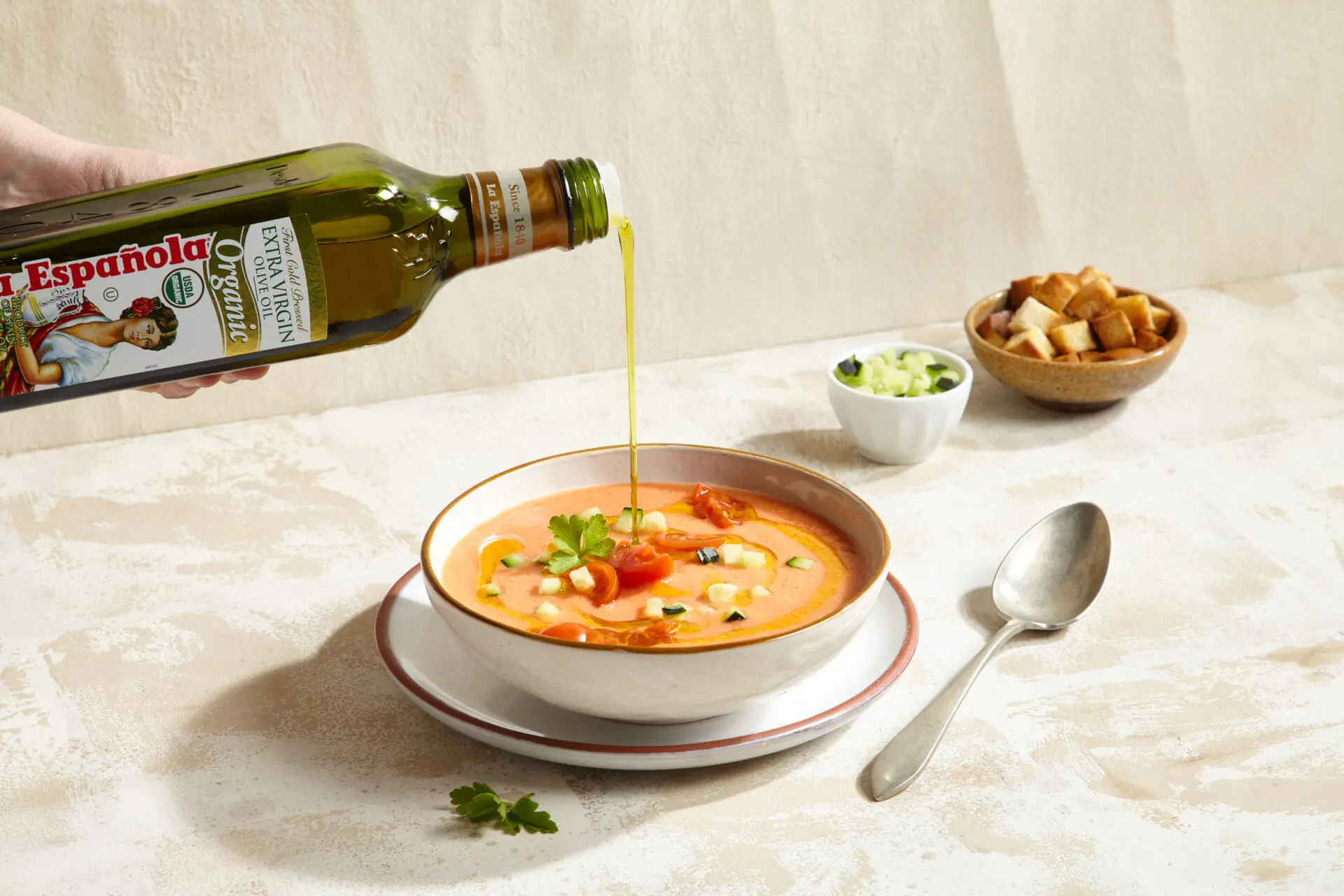There’s something special about summertime in Spain. The sun climbs high in the sky, and new and refreshing ingredients come into season, bringing color and vibrancy to meals. The seasonal dimension to Spanish cuisine is essential to unlocking its flavors. Anyone who has visited this unique part of the world will have noticed the proliferation of salmorejo and gazpacho recipes in summer. Often served as appetizers or light lunch options, these cool, refreshing tomato-based soup recipes hit the spot in the warm weather. So, let’s delve into the art of making salmorejo and gazpacho, exploring the difference between these two summer staples, and fun variations to experiment with along the way.
Understanding Salmorejo and Gazpacho
Salmorejo and gazpacho are traditional cold soups from Andalusia, Spain. Popular during the summer months for their refreshing qualities and vibrant flavors, each soup has a unique preparation and offers a different taste experience. They offer a refreshing respite from the heat, particularly during the summer months.
Origins and Cultural Significance
The roots of these exquisite soups can be traced back to Southern Spain, where the hot climate made cold dishes a necessity. Gazpacho and salmorejo have historical connections to agricultural practices, showcasing the bountiful produce of the Andalusian region.
Gazpacho’s origins date to ancient agrarian communities, evolving over centuries into the refreshing dish we know and love today. Its unique blend of ingredients, which includes tomatoes, cucumbers, and peppers, embodies the seasonal spirit that has come to define Andalusian cuisine.
Salmorejo, originating in Córdoba, reflects the influence of Arabic culture during the medieval period. Initially, it was a mixture of stale bread, garlic, and olive oil, and didn’t feature tomatoes. Through time, however, the dish evolved to incorporate tomatoes, transforming salmorejo into the beloved dish it is today.
This transformation highlights the adaptability of Andalusian cuisine, making both soups a representation of local culture and a testament to how historical influences have shaped modern culinary practices.
Differences Between Salmorejo and Gazpacho
While salmorejo and gazpacho are often confused, they are distinctly different in both texture and ingredients. Each soup showcases a unique flavor profile that speaks to the creativity of Spanish cuisine.
- Texture: Salmorejo is thick and creamy due to the presence of stale bread, while gazpacho is more broth-like and light, resulting from a blend of various vegetables. While both dishes call for stale bread as part of the ingredients, gazpacho only requires a small amount to achieve the desired lightness of its consistency. In addition, ice cubes or cold water are added to accentuate the refreshing qualities of gazpacho. In salmorejo, however, water is used in smaller quantities merely to adjust the texture.
- Ingredient Variety: The primary ingredient in both soups is ripe tomatoes, but salmorejo primarily relies on this one ingredient along with bread, while gazpacho incorporates additional vegetables such as cucumbers, bell peppers, and onions.
- Serving Style: Salmorejo is typically served in bowls, garnished with toppings like hard-boiled eggs and jamón serrano. Gazpacho, on the other hand, is often served in tall glasses, making it more versatile as a drink or appetizer.
Through these differences, both soups celebrate the flavors of Andalusia. They each offer something unique, allowing individuals to enjoy the essence of Spanish summer in diverse ways.
How to Make Gazpacho at Home

Now that we’ve got to grips with the origins and significance of these Spanish culinary classics, let’s look at how you can make homemade gazpacho. This Classic Spanish Gazpacho Recipe is the perfect place to start your journey. Featuring traditional gazpacho ingredients such as tomato, garlic, green pepper, peeled cucumber, and—the cherry on top—La Española Extra Virgin Olive Oil. Affectionately applied in glistening swirls, most Spaniards will tell you that the secret to a successful gazpacho recipe is having quality extra virgin olive oil as a garnish.
Classic Salmorejo Recipe
Salmorejo, in comparison to gazpacho, is a heartier proposition. The addition of stale bread brings texture to the dish, giving it a brothy consistency. This easy Salmorejo recipe honors centuries of Spanish culinary tradition. Topped with tender strips of jamón ibérico, crumbled boiled egg, and La Española Organic Extra Virgin Olive Oil, it’s a fruity and flavorful soup that delights and revitalizes in equal measure. It’s no wonder that salmorejo is quickly becoming a summertime staple all over the world.

Selecting the Best Tomatoes
The foundation of both salmorejo and gazpacho lies in the quality of the tomatoes. Ripe, in-season tomatoes are essential for developing rich flavors. Various varieties, such as Roma or heirloom tomatoes, are particularly recommended for their sweetness and juiciness. Choose tomatoes that are brightly colored, slightly soft to the touch, and have a fresh aroma. This selection ensures that the soups achieve that vibrant essence characteristic of Spanish cuisine.
Blending Techniques
When blending ingredients, starting with the tomatoes provides a good base. Gradually add other ingredients like bread and olive oil, and blend until smooth. For salmorejo, allowing for a thorough blending time ensures a creamy texture without any lumps. In the case of gazpacho, blending just until the mixture is smooth while retaining some vegetable texture can provide a delightful contrast.
Adjusting Consistency
If salmorejo turns out too thick, a splash of cold water while blending can help reach the desired creamy consistency. For gazpacho, if it feels too runny, incorporating a small amount of stale bread can help thicken it while adding flavor. Tasting throughout the blending process helps ensure the right texture is achieved.
Benefits of Using Extra Virgin Olive Oil
Using quality olive oil in salmorejo and gazpacho recipes elevates the flavor profile of the dish, adding fruitiness and aroma to the dish. What’s more, extra virgin olive oil brings additional health benefits to boot. Studies show that cooking with extra virgin olive oil is linked to improved cardiovascular health. Rich in fiber, monounsaturated fats, and antioxidants, extra virgin olive oil is a wholesome ingredient that improves the nutritional profile of dishes, especially when used in place of vegetable oils or butter.
For more recipe ideas and cooking tips, check out our blog.
